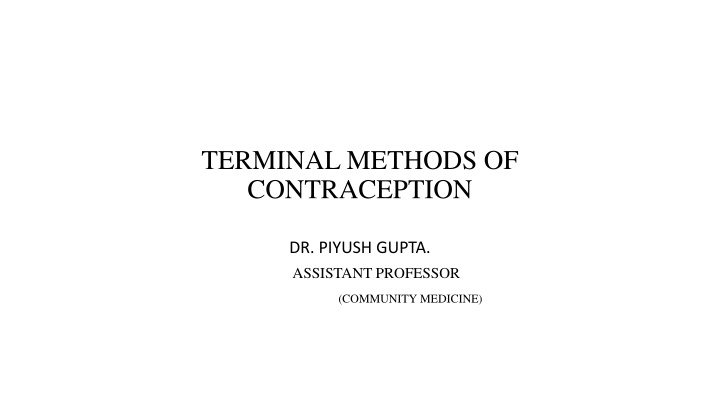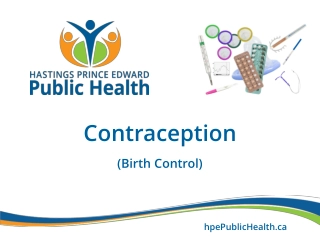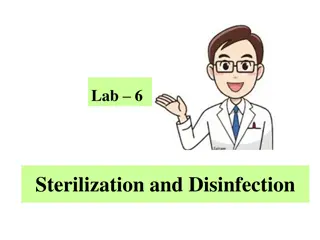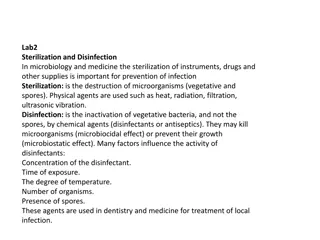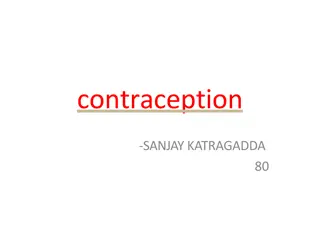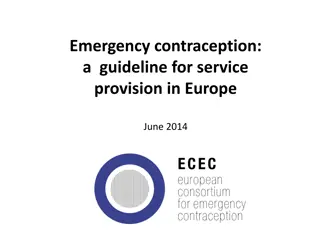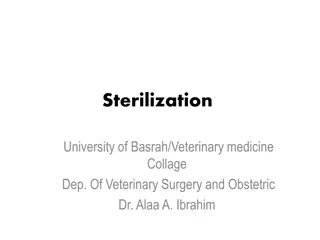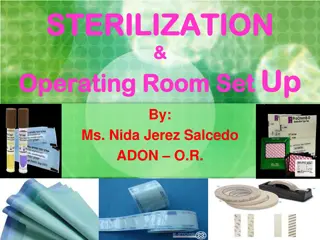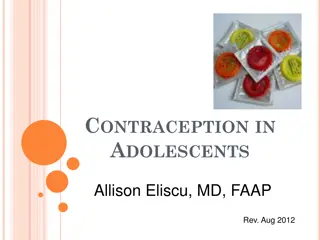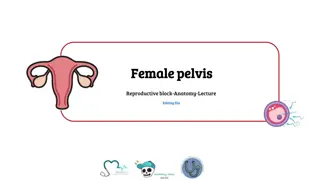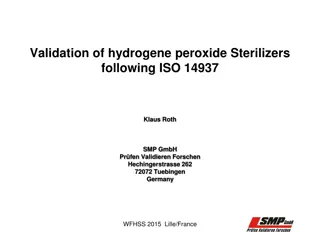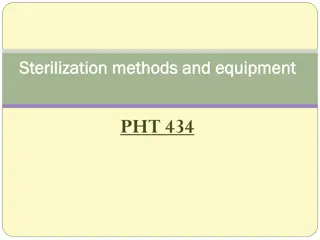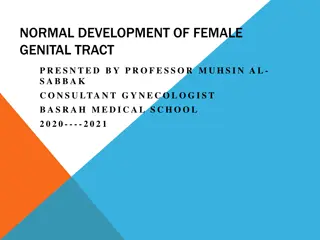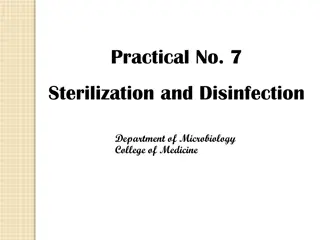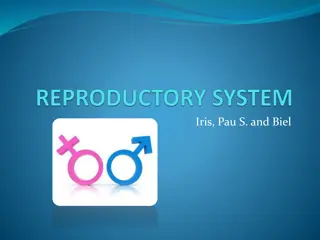Terminal Methods of Contraception: Male and Female Sterilization
Various contraceptive methods are practiced to prevent unwanted pregnancies, including terminal methods like male and female sterilization. These one-time procedures offer highly effective protection and are provided free in government institutions. Basic guidelines for sterilization eligibility include age and number of living children. Male sterilization is a safe, simple, and permanent family planning method that does not affect sexual function or testes, while female sterilization is similarly effective.
Download Presentation

Please find below an Image/Link to download the presentation.
The content on the website is provided AS IS for your information and personal use only. It may not be sold, licensed, or shared on other websites without obtaining consent from the author.If you encounter any issues during the download, it is possible that the publisher has removed the file from their server.
You are allowed to download the files provided on this website for personal or commercial use, subject to the condition that they are used lawfully. All files are the property of their respective owners.
The content on the website is provided AS IS for your information and personal use only. It may not be sold, licensed, or shared on other websites without obtaining consent from the author.
E N D
Presentation Transcript
TERMINAL METHODS OF CONTRACEPTION DR. PIYUSH GUPTA. ASSISTANT PROFESSOR (COMMUNITY MEDICINE)
WHAT ARE CONTRACEPTIVE METHODS? THE CONTRACEPTION IS PART OF FAMILY PLANNING. IN THIS WE PRACTICE THOSE PREVENTIVE METHODS TO AVOID UNWANTED PREGNANCIES.
THERE ARE VARIOUS METHODS FOR CONTRACEPTIONS WHICH ARE CLASSIFIED BROADLY IN TO TWO GROUPS. 1- SPACING METHODS. 2- TERMINAL METHODS.
TODAYS TOPIC OF DISCUSSION IS TERMINAL METHODS OF CONTRACEPTION, WHICH INCLUDES MALE STERILIZATION AND FEMALE STERILIZATION .
Conti.. THESE METHODS ARE SUITABLE FOR THOSE COUPLES WHO DESIRING NO MORE PREGNANCIES. THE MOST COMMON BENEFIT IS IT S A ONE TIME METHOD AND PROVIDE MOST EFFECTIVE PROTECTION AGAINST PREGNANGY. THESE SERVICES ARE PROVIDED FREE OF CHARGE IN GOVERNMENT INSTITUTIONS.
WHO CAN ADOPT THESE METHODS? THE BASIC GUIDELINE FOR STERILIZATION ARE- AGE- FOR (HUSBAND /MEN )NOT BE LESS THAN 25 YRS NOR SHOULD IT BE OVER 50 YEARS. FOR (WIFE / FEMALE ) NOT BE LESS THAN 20 YRS OR MORE THAN 45 YEARS. THE MOTIVATED COUPLE MUST HAVE 02 LIVING CHILDREN AT THE TIME OF OPREATION.
CONTI.. IF THE COUPLE HAS 03 OR MORE LIVING CHILDREN THE LOWER LIMIT OF AGE OF HUSBAND AND WIFE MAY BE RELAXED AT THE DISCRETION OF THE OPREATING SURGEON .
MALE STERILIZATION This is Simple, safe, very effective, cheap, convient, permanent and quick surgical method of family planning . Does not affect testis and sexual activity.
Procedure A small incision is made on scrotum on either side above the testis under local anaesthesia under aseptic precautions. Vas deferens tube lifted, cut and tied with thread or clamped and incision closed with stitches, bandage is put.
NO SCALPEL VASECTOMY It is new technique more safe and acceptable to males. In this only one small puncture is made instead of incision. At the end not sutured. Short duration, less painful and bruising and shorter recovery time.
INSTRUCTION AFTER SURGERY 1. Rest for 2 days and not do any heavy workor vigorous exercise for few days. 2. Wound kept clean and dry. 3. Put ice for four hours on scrotum to lessen swelling. 4. wear snug underwear or paints for 2-3 days. 5. Can have sex within 2-3 days but use condom or other contraceptive measures for 3 months
EFFECTIVENESS Highly effective and permanent method. Failure rate 0.15 pregnancies/100 men in 1styear after procedure.
MERITS 1. Simple, safe highly effective and lifelong permanent method. 2. Except to use condom till becomes aspermic. 3. Prolonged sexual pleasure 4. Vasectomy easy to perform. 5. Can be done even in clinic. 6. Does not require hospitilization.
DEMERITS 1. Pain in scrotum, swelling and bruising 2. Uncomfortable for 2-3 days. 3. Feeling faintness after procedure. 4. Bleeding or infection of wound. 5. Blood clots in scrotum. 6. Not immediately effective, only when becomes aspermic.
Female sterilization (Tubectomy) Voluntary surgical contraception for female or can be done as an interval procedure post-partum or at the time of abortion. The common two procedures are- A- Laproscopy B- Minilap operation
Laproscopy This operation should be undertaken where specialist Gynaecologist is available. Ideally operation performed within a week of menstrual period, confirms fertility and absence of pregnancy. Post op instruction 1. Rest for 2-3days and avoid strenuous work for 1 week. 2. Keep wound clean and dry. 3. Not to have sex 1 week or pain is gone. 4. To report if develop fever, bleeding or pus in wound.
Effectiveness- Failure rate 0.5 pregnancies/100women. Postpartum tubal ligation most effective female sterilization technique. In 1styear 0.05 pregnancies /100 women years
Merits- 1. Simple, safe and very effective, permanent and lifelong method of FP. 2. Nothing to remember. 3. No interference with sex. 4. No effect on breast milk. 5. No long term side effect. 6. Helps to protect against ovarian cancer.
Demerits- 1. Usually painful for several days after surgery. 2. Postoperative infection or bleeding. 3. If pregnancy occur, more likely to be ectopic. 4. Slightly more risky and expensive. 5. Reversal surgery not possible. 6. Does not protect against STDs including HIV/AIDS.
Contraindication of Laparoscopy - Laparoscopy is not advisable for post-partum patients for 06 weeks following delivery. Also not advisable for female with Hb below 08 gm%. She should not be associated with any medical illness like CAD, DM,HTN, Respiratory illness.
Minilap operation - It s a modification of abdominal tubectomy . Much simple as care to laproscopic procedure. It is also suitable for post partum tubal ligation .
Evaluation of contraceptive methods- It generally assessed by measuring the number of unplanned pregnancies that occur during a specified period of exposure and use of contraceptive methods. Two methods to measure contraceptive efficacy are 1-Pearl index. 2- Life table analysis.
Pearl index- It is define as number of failure per 100 woman year of exposure . Failure rate per HWY = total accidental pregnancies X1200 total months of exposure A failure rate of 10 per HWY would mean that in the life time of average woman about one-fourth , or 2.5 accidental pregnancies would results, since the average fertile periods of a woman is about 25 years.
Life table analysis- it calculates a failure rate for each month of use. A cumulative failure rate can then compare methods for any specific length of exposure.
Key points to remember - Terminal methods also called permanent methods Vasectomy in male and tubectomy in female. Age between 25-50 years in male and 20-45 years in female. Both procedures are relatively safe and ruqiures small incision. In vasectomy we cut vas defense , while in Tubectomy we cut fallopian tube . Tubectomy is contraindicated if female having hemogram below 08 gm%, any medical background history .
The pearl index and life table analysis are methods for wevaluation of contraceptive methods.
